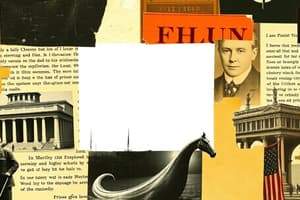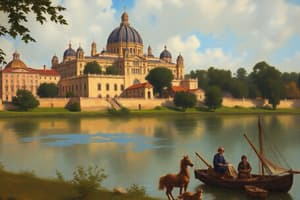Podcast
Questions and Answers
What is a primary source?
What is a primary source?
- A modern re-enactment of a historical event.
- A document or artifact created by a witness. (correct)
- An interpretation of past events.
- A textbook analyzing historical periods.
Why is it important to consider the physical nature of a primary source?
Why is it important to consider the physical nature of a primary source?
- To assess its aesthetic appeal.
- To verify its authenticity easily.
- To determine its monetary value.
- To understand its historical context. (correct)
What should you identify when analyzing communication in a primary source?
What should you identify when analyzing communication in a primary source?
- The market value of the document.
- The font used in in the document.
- The author's biases (correct)
- The document's length.
Why is context important when analyzing a primary source?
Why is context important when analyzing a primary source?
What is one of the main goals when analyzing a primary source?
What is one of the main goals when analyzing a primary source?
What does the '6 C's' framework guide you to do?
What does the '6 C's' framework guide you to do?
What should you identify as part of content analysis?
What should you identify as part of content analysis?
What is the purpose of analyzing the citation of a primary source?
What is the purpose of analyzing the citation of a primary source?
What is bias, in the context of analyzing primary sources?
What is bias, in the context of analyzing primary sources?
What does 'context' refer to when analyzing primary sources?
What does 'context' refer to when analyzing primary sources?
Why is it important to make connections when using primary sources?
Why is it important to make connections when using primary sources?
What is the goal of drawing conclusions from primary sources?
What is the goal of drawing conclusions from primary sources?
Analyzing primary sources helps with critical examination because sources are...
Analyzing primary sources helps with critical examination because sources are...
What type of source provides firsthand evidence about an event?
What type of source provides firsthand evidence about an event?
What is a secondary source?
What is a secondary source?
What is internal criticism in historical analysis?
What is internal criticism in historical analysis?
What does external criticism do in historical analysis?
What does external criticism do in historical analysis?
Why is history vital?
Why is history vital?
What is history often based on?
What is history often based on?
What is the definition of 'history'?
What is the definition of 'history'?
Which group was exempt from taxation during the pre-colonial period?
Which group was exempt from taxation during the pre-colonial period?
What was the tax or tribute called in the pre-colonial Philippines?
What was the tax or tribute called in the pre-colonial Philippines?
What tax replaced the Urbana tax during the American colonial period?
What tax replaced the Urbana tax during the American colonial period?
What act created the Bureau of Internal Revenue (BIR)?
What act created the Bureau of Internal Revenue (BIR)?
What triggered the abolition of the Cedula tax?
What triggered the abolition of the Cedula tax?
What new tax system was implemented during the Commonwealth period?
What new tax system was implemented during the Commonwealth period?
What were the three classes during the pre-colonial period that paid taxes?
What were the three classes during the pre-colonial period that paid taxes?
What is agrarian reform?
What is agrarian reform?
What is CARP?
What is CARP?
What does land reform seek to eliminate?
What does land reform seek to eliminate?
What is a key objective of agrarian reform?
What is a key objective of agrarian reform?
What is the main economic aspect of agrarian reform?
What is the main economic aspect of agrarian reform?
What is one effect of agrarian reform on socio-cultural aspect?
What is one effect of agrarian reform on socio-cultural aspect?
Aquino signed what act into law?
Aquino signed what act into law?
What type of system did the Spanish introduce during their colonization?
What type of system did the Spanish introduce during their colonization?
What is the paramount law of the land?
What is the paramount law of the land?
What is the purpose of a constitution?
What is the purpose of a constitution?
What constitution was known as the Freedom Constitution?
What constitution was known as the Freedom Constitution?
What is the most important job of the historian?
What is the most important job of the historian?
What does 'content' refer to in the 6 C's framework for analyzing primary sources?
What does 'content' refer to in the 6 C's framework for analyzing primary sources?
What is one characteristic of a primary source?
What is one characteristic of a primary source?
What is the purpose of studying history?
What is the purpose of studying history?
What is the term in Tagalog for a tribal gathering?
What is the term in Tagalog for a tribal gathering?
Flashcards
Primary Source
Primary Source
Documents or artifacts created by a witness to or participant in an event, providing direct evidence from the time studied.
Analyzing Primary Sources
Analyzing Primary Sources
Asking questions to understand its context, purpose, and the author's perspective, using historical imagination.
Examples of Primary Sources
Examples of Primary Sources
Journals articles, letters, court records, novels, artworks, music, or autobiographies from the time period.
Analyzing a primary source
Analyzing a primary source
Signup and view all the flashcards
Citation (in primary source analysis)
Citation (in primary source analysis)
Signup and view all the flashcards
Communication (in source analysis)
Communication (in source analysis)
Signup and view all the flashcards
Context (in source analysis)
Context (in source analysis)
Signup and view all the flashcards
Connections (in source analysis)
Connections (in source analysis)
Signup and view all the flashcards
Conclusions (in source analysis)
Conclusions (in source analysis)
Signup and view all the flashcards
Juan de Plasencia
Juan de Plasencia
Signup and view all the flashcards
Juan de Plasencia's role
Juan de Plasencia's role
Signup and view all the flashcards
Dato
Dato
Signup and view all the flashcards
Barangay
Barangay
Signup and view all the flashcards
Three Castes
Three Castes
Signup and view all the flashcards
Government in ancient Philippines
Government in ancient Philippines
Signup and view all the flashcards
Chieftain's role
Chieftain's role
Signup and view all the flashcards
Inheritance
Inheritance
Signup and view all the flashcards
Slaves
Slaves
Signup and view all the flashcards
Slaves freedom
Slaves freedom
Signup and view all the flashcards
Marriage customs
Marriage customs
Signup and view all the flashcards
Dowry
Dowry
Signup and view all the flashcards
Religious Beliefs
Religious Beliefs
Signup and view all the flashcards
Early form of writing
Early form of writing
Signup and view all the flashcards
History
History
Signup and view all the flashcards
Primary Source
Primary Source
Signup and view all the flashcards
Secondary Source
Secondary Source
Signup and view all the flashcards
Internal Criticism
Internal Criticism
Signup and view all the flashcards
External Criticism
External Criticism
Signup and view all the flashcards
Value of History
Value of History
Signup and view all the flashcards
Agrarian Reform
Agrarian Reform
Signup and view all the flashcards
Agrarian Reform Objectives
Agrarian Reform Objectives
Signup and view all the flashcards
Economic Aspect (Agrarian Reform)
Economic Aspect (Agrarian Reform)
Signup and view all the flashcards
Socio-Cultural Aspect (Agrarian Reform)
Socio-Cultural Aspect (Agrarian Reform)
Signup and view all the flashcards
Comprehensive Agrarian Reform Program (CARP)
Comprehensive Agrarian Reform Program (CARP)
Signup and view all the flashcards
"Pueblo" System
"Pueblo" System
Signup and view all the flashcards
Land Reform Act of 1955 (R.A 1400)
Land Reform Act of 1955 (R.A 1400)
Signup and view all the flashcards
Constitution of the Republic of the Philippines
Constitution of the Republic of the Philippines
Signup and view all the flashcards
Barangay
Barangay
Signup and view all the flashcards
"Urbana"
"Urbana"
Signup and view all the flashcards
Bureau of Internal Revenue (BIR)
Bureau of Internal Revenue (BIR)
Signup and view all the flashcards
Residence Tax
Residence Tax
Signup and view all the flashcards
Taxation
Taxation
Signup and view all the flashcards
Direct Taxes
Direct Taxes
Signup and view all the flashcards
Indirect Taxes
Indirect Taxes
Signup and view all the flashcards
Tax
Tax
Signup and view all the flashcards
Study Notes
Analyzing Primary Sources
- Primary sources consist of documents or artifacts from a witness or participant in an event
- They provide firsthand evidence from the time period under study
- Examination of primary sources is key to understanding the past
- Diverse backgrounds lead to varied interpretations of primary sources
- Analysis requires knowledge of the document and its historical context
- Interpretations should be thorough and careful
Helpful Questions for Analyzing Sources
- Consider the source's physical nature, asking what can be learned from its form
- Determine the source's purpose and the author's message, both explicit and implicit
- Identify the author's methods for conveying their message
- Analyze what you know about the author (race, sex, class, etc.) and its relevance
- Determine the intended audience and its impact on the source
- Analyze the language, metaphors, and symbols used and what they reveal about the author's choices
The 6 C’s of Primary Source Analysis
- Content: Identify main ideas, important points, phrases, words, and descriptions
- Citation: Determine the document's creator and creation date
- Communication: Identify the author's biases and point of view
- Context: Understand the world, country, region or locality when the document was created
- Connections: Relate the source to existing knowledge
- Conclusions: Assess the source's historical contributions
- Examine primary sources with a critical eye
Background of Juan de Plasencia
- His real name was Joan de Puerto Carrera, Del Convento De Villanueva De La Serena and was a Spanish Franciscan friar
- Born as Juan Puerto Carrero in the early 16th century in Plasencia, Extremadura, Spain
- He helped spread primary education and converted natives
- He taught catechisms and organized towns and barangays
- He promoted Spanish among natives and local languages among missionaries
- He initiated the Reduction Policy to resettle natives centrally
- His work aimed to address injustices against natives by officials
Arrival in the Philippines
- Credit is given to the foundation of a number of towns in Bulacan, Laguna, and Rizal
- Served as custos of the friars, 1584-1588
- Passed away in Laguna in 1590
- Chiefs were called Dato, who governed and led in wars
- Tribal gatherings were called barangays in Tagalog, comprising families and slaves
The Three Castes
- Nobles (Maharlica): Free-born individuals who did not pay taxes
- Commoners (Aliping Namamahay): Lived in their own houses and were lords of property and gold
- Slaves (Aliping Saguiguilid): Served masters and could be sold
Mode of Dressing
- For Males, Putong (headgear, symbolizes how many killed), kanggan (upper jacket with short sleeves), and bahag (lower)
- For Females, Baro at Camisa (upper) and Saya (lower)
Ornaments
- Ornamental objects or features gave distinction to person, place, or thing
Government
- The unit of government was the barangay which was ruled by a chief and consisted of 30-100 families with relatives and slaves
Administration of Justice
- Chieftain implemented laws, ensured order, gave protection to the subject.
- Disputes were settled by a court led by the chief and council of elders
Inheritance
- The first son inherited the chieftain's position
- Absence of male heirs led to the eldest daughter becoming chieftain
Slaves
- Slavery occurred by capture of war, debt, inheritance, purchase, or crime
- Emancipation happened by forgiveness, debt payment, condonation, bravery, or marriage
Marriage Customs
- Men were generally monogamous with wives called Asawa
- Courtship involved Paninilbihan
- Dowry was required (Bigay-kaya, panghihimuyat, Bigay-suso)
- Marriage was uncommon between different social classes
Religious Belief
- Worshiped many Gods and Goddesses: Bathala (supreme being), Idayanale, Sidarapa, Agni, Balangaw, Mandarangan, Lalahon, Siginarungan
- Belief in sacred animals and trees was also evident
Superstitious Beliefs
- Beliefs included Aswang, Duwende, Kapre, Tikbalang, and Tiyanak
- Belief in amulets and charms (anting-anting, kulam, gayuma) existed
Language and System of Writing
- Major languages are Tagalog, Ilocano, Pangasinan, Pangpangan, Sugbuhanon Hilighaynon, Maguindanao, and Samarnon
- The languages originated from Malayo-Polynesian
- The writing system had 3 vowels and 14 consonants called Baybayin
- Tree sap was used as ink with pointed sticks as pencils
- Large plant leaves, tree bark, or bamboo tubes were used for writing
Definition of History
- Derives from Greek "historia" (inquiry, knowledge from investigation)
- It is the study and description of the past in written documents
- It provides insights into books, documents, artifacts, digital media, and places from the past
Relevance of History
- Inescapable and studies the past and its effects on the present
- Connects events through time and promotes historical understanding
Primary Source Historical Data
- Provides firsthand evidence through, event, object, person, or work of art
Secondary Source Historical Data
- It was not made by people involved in the historical era
Two Ways of Evaluating Historical Data
- Internal criticism: Looks within the data for truth and reasonable interpretation
- External criticism: Applies scientific methods to verify authenticity
Conclusion
- History is essential to understand current issues
- Primary and secondary sources must be evaluated
Introduction
- Humans adapt to physiological needs and environmental changes
- Cognitive skills develop from basic needs
- Inventions like spears, bows, and arrows served as extensions of human capabilities
- Responses to weather such as volcanic eruption, storms, and tidal waves result to fears and need to protect oneselves
Further Insights on Studying History
- The world is explored, machines and symbols are invented, leading to the formation of civilizations.
- Exploration, research, and discovery lead to intrigue
- Examination of diverse worlds, times, places, and peoples helps
Meaning and Relevance of History
- The past is examined, focusing on human affairs and its connection to events or individuals
- Human innovation and colonization resulted in conflicts
- Historical record are on papyrus, walls, temples, coliseums, sphinxes, and obelisks
- Ancient writings guide comprehension of later event
Social Science of History
- Used to understand past events
- The past shapes the present and could affect the future
- Collective knowledge leads to legacy that will be inherited and used by future generations
- The belief in continuous existence encourages people to leave footprints
- People are enabled to develop skills, understand the world, and gain insight into ourselves and unfamiliar cultures
2 Categories of Historical Data
- Primary and secondary sources
Primary Source Specifics
- They give firsthand accounts
- They provide insight knowledge and detail
- The evidence of human avtivity is compelling
- Originate from the time of past events
- Offer direct evidence through archives, photos, journals, artifacts, and research
Primary Source Characteristics
- Observations are made at the time, with contemporary documents
- Events are recorded, with all viewponts of people at the time
- Event driven, as opposed to an era
- Representation of one person's perspective, viewed with secondary sources
- Analysis of sources requires you to be sensitive to the bias of the time
- The researcher has significant perspective for the evidence to be primary
- Reproductions remain primary
Secondary Source Characteristics
- Originate by historians, based on primary sources
- Provide interretation of history, and after the fact
- They can summarise what happened in a past event
Seconary Source Examples
- Textbooks and magazine articles
Ways of Evaluating Historical Data
- Historical sources are examined for validation before publication
- Scholastic writers and historians are responsible for ensuring accuracy
Internal Criticism
- There is a search for truth and accuracy in each source
- The motives of each source must be considered- positive or negative
- Historical facts must be accurate and verifiable
External Criticism
- Authenticity is measured, and each source is verified by science
- All data must be technically verifiable
- Genuineness can also be gauged and tested
Internal and External Criticisms are key to history evaluation
- Every detail must be scrutinised
- Keepers of critical events in time and in the past
Conclusion
- History is a road to knowledge as it uncovers past issues
- All issues are unique due to the nature of time
- A deeper and more dangerous understanding cannot be achieved without knowledge and history
- It is viewed as an aid and key to unlocking identity, if all items are scrutinised
Social, Political, Economic and Cultural Issues in Philippine History
- Agrarian reform can break the cycle of proverty
Social, Political, Economic and Cultural Issues in Philippine History
- It is a redistrubution of lands, to provide economic status to beneficiaries
- Aims to ensure that all conflicts end, and peace ensues
- This occurs in accordance with economic and social development
- Aims need to focus on motivating famers to own the land that they till
- A socio-cultural change must ensure surplus for selling
- The people must be more invovled in practicing leardeship roles
- As reform increases family income, their children can attend school.
- Reformation also promotes modern ideas
- Biblical ideas are often related to God and food
Objective of Agrarian Reform
- The main aim of is that it will end all conflicts
- Social equality must ensure
- The programs assist the implementation
Comprehensive Agrarian Reform (CARP)
– Republic Act 6657: Land redistribution to landless farmers/workers.
History of Agrarian Reform
- CARP seeks to hasten land distributation
- The Philippines, pre colonization, already had organized commmunities in the form of Batangays
- Pueblo was an agricultural system used by the Spanish
- Hukbalahap was used as an anti-japanese group
- The Rice Tenancy Law, authorized by Manuel L Quezon, was the first known of that date
- The Republic Act No.34, was created by Manuel Roxas, to create a agreement
Elpidio Quirino's Era
- Instituted development of land for settlement President Magsaysay promoted pursuing land reform
- Pursuing land reform
Agrarian Reform Acts
- Land Reform Act of 1955 (R.A 1400) carries the policy
- REVISED AGRICULTURAL LAND REFORM CODE (R.A 6389), abolished subdivisions
- There was also automatic share conversion and creation of rights
Lands Coverered by the Code
- Tenanted and landed areas
Land covered by CARL
- All are all disposable and alienable
- All of the public domain must be utilized
- All private, and government utilized land
Qualified Beneficiaries
- All agricultural, seaonal and regular workers, occupants or tillers of land
- All must be cooperatives in their collection
Comprehensive Agrarian Reform Program Extension with Reform (CARPER LAW)
Strengthened and improved CARLand has $150B funding
- There were seven new, over 26 reformed provisions
- The government needs to have balance and ensure farmers
The Purpose of the Constitution
- The constitution is the fundamental law of the land
- They provide the government and framework
Constitution of the Philippines
- Malolos Constitution congress after declaration of independence
- The 1935 Constitution of the Philippines independence was necessary for all
- The 1943 Constitution of the Republic of the Philippines the legislation consited of those against U.S to be elected
- *1973 Constitution of the Republic of the Philippines * shift from the elected system to a parliamentary one
- *1986 Provisional Constitution * After the People Power Revolution, the President legislated
Contitution of the Republic
- It occurs on Feburary 2, 1987
History of Taxation in the Philippines
- Buwis and Handug, taxations with barangays
- The three classes were identified (tumao,timawa and oripun)
Taxation in the Spanish and American
- Following the spanish, U.S taxes replaced rental with a charge on both land and rural estate
- Bill Taft (1902), and Wright(1904)
- There was an internal revenue (1904)
- Amendments and taxes were made to internal revenue (1904)
- Internal Revenue (1904) licences and tariffs
- Amendmentcedula change and tax (1907)
- US Pres had act enacted( Underwood-Simmons Tariff Act (1913)
- Levies were reduced and raw meterial elminated
Sources of Taxes
- Tax act (1914) was enacted, as well as Inheritance (1919)
- They could not be payed be lower class, especially in (1937)
- Commonwealth (1940) period enacted residence tax
Who was except from Taxes
U.S high and foreign ranking individuals
New Sources of Taxes (regime periods)
- New tax reform
Post War Era and Reforms
- Tax revenues could not pay to the economy, especially for those with low income
- New legal laws needed to be enancted, one of which occured in January 1951, when three departments wer created (Legal, Assement, Collection)
- Another addition was the Memorandum Order (1995), or assessment
- This unit generated most of their income
- March 1954 revenue created more division
- All of these laws required administration The bureau often had people who were against tax
There was appointment of Misael Vera as commissioner
- This lead to people who needed tax aid
- All personel benefitted and abused these systems
Government often encouraged honest practises
- Payment system, through banks was launched
- Marcos needed tax laws
- Amnestys were issued on the people
- Many different systems were created to benifit population
Tax Code
- In 1977 tax code launched, for first timers tax
- 12 storey building was used to store data and other files of tax
- The life blood of history (taxes), is impoosed to all
- There are many enforced laws which are related and payed by all classes
Types of taxes
- Capital gain
- Withholding
- Property
- Inheritance
- All people ahve to follow the rules
Types (cont)
There are two kinds
- Direct which is shouldered and payed by the taxpayer, and others known as value added.
- Excise must be made for manufacturer and importer
Other Forms of Tax Laws
- All must have equal equity (tax is based on level of ability)
- Certainty: a plan should be ensured, and an exact time (to be sure nobody can oppresive)
The Three Phases of Laws
- Levying is always impacted in the start, the government can always choose the source for benifits
- It will follow the rules of the assessment and collections
- The payment is reference
Studying That Suits You
Use AI to generate personalized quizzes and flashcards to suit your learning preferences.




